AutoElectric VehiclesI drifted a Polestar 3 EV across a frozen Swedish lake for scienceDrifting the Polestar 3 on ice reveals the secrets of torque vectoringWhen you purchase through links on our site, we may earn an affiliate commission.Here’s how it works.
AutoElectric VehiclesI drifted a Polestar 3 EV across a frozen Swedish lake for scienceDrifting the Polestar 3 on ice reveals the secrets of torque vectoringWhen you purchase through links on our site, we may earn an affiliate commission.Here’s how it works.
Drifting the Polestar 3 on ice reveals the secrets of torque vectoring
When you purchase through links on our site, we may earn an affiliate commission.Here’s how it works.
(Image credit: Polestar)
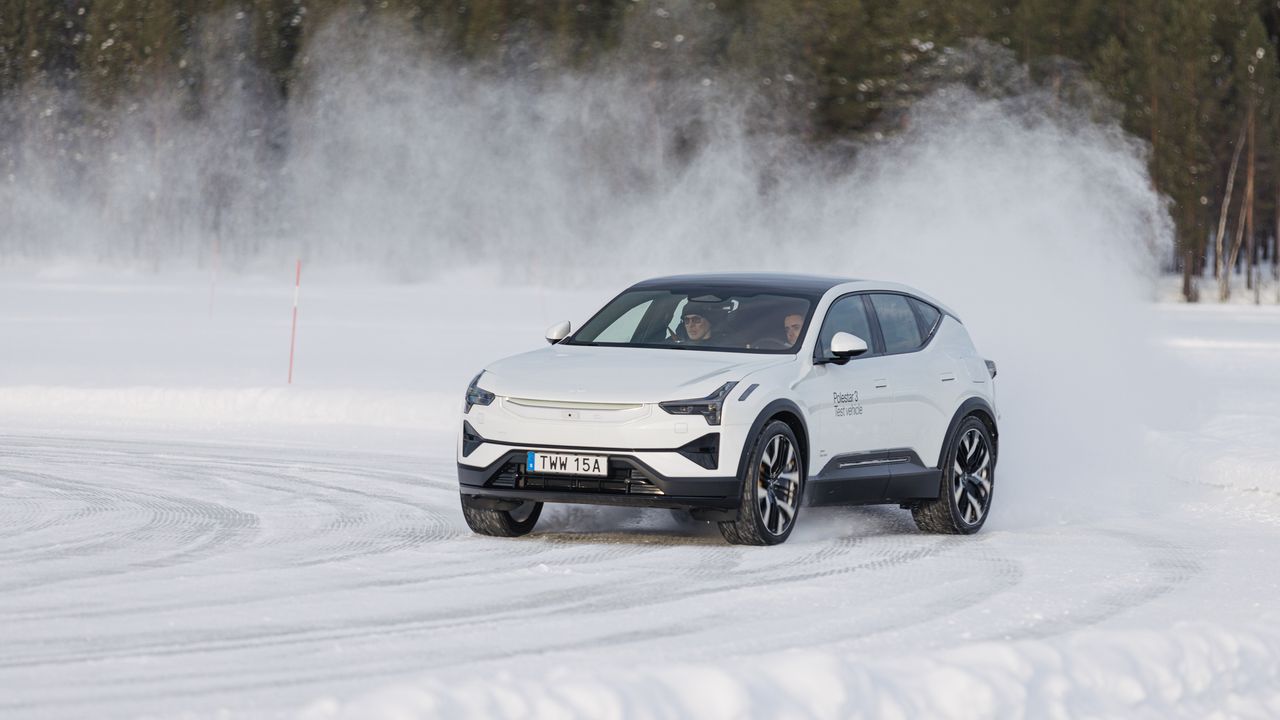
(Image credit: Polestar)
Located just above the Arctic Circle and with a population of fewer than 3,000 people, you would be forgiven for not knowing much about the Swedish town of Jokkmokk. It’s a two-hour drive north of Luluå, a larger town that’s an hour’s flight from Stockholm, but that’s also unlikely to have troubled your radar. Kayaking is popular here in the summer, while hardy winter tourists come for week-long dog sled expeditions without a hotel in sight. The past winter saw temperatures in Jokkmokk fall to -40C, which, as convenient as it is weird, is also -40F.
I’m here, on a positively balmy (-15C) Tuesday in late February, as one of the first journalists to drive the new Polestar 3electric vehicle. But instead of a marathon drive back to the UK, I’ll be sticking to the ice. I’m here to learn how the electric motors and enormous brains of new cars are designed and programmed to deal with slippery roads in ways internally combusted cars cannot.
(Image credit: Polestar)

(Image credit: Polestar)
Polestar engineers and test drivers have spent the last two months up here, braving the conditions and forgetting what paved roads look like, to fine-tune the 3 before it goes on sale later in 2024. They were here last year too, and they’ll be back again when the snow returns in early December.
Winter testing like this is a common part of car development, with manufacturers flocking to Swedish Lapland every year in massive numbers. The better-known town of Arjeplog – where Iexperienced the Jaguar Ice Academy last winter– is where most companies go, filling every hotel room, keeping the pizzerias in business and trying to avoid snowmobile-riding automotive paparazzi from snapping their camouflaged prototypes. In Jokkmokk, 120 miles to the north-east, things are much quieter.
(Image credit: Polestar)

(Image credit: Polestar)
Ice driving helps test and calibrate stability systems in extreme conditions, but it also lets engineers look at the Polestar 3’s driving dynamics in slow motion. This is because, when a car loses traction and begins to slide on ice, wearing studded tyres, it does so more slowly than on dry tarmac, giving engineers a better understanding of what’s going on and how to tweak the setup.
Before we get to the fun – I mean, sliding the car in a controlled and scientific manner – let’s have a quick look at the Polestar 3 itself.
Sign up to the T3 newsletter for smarter living straight to your inbox
Get all the latest news, reviews, deals and buying guides on gorgeous tech, home and active products from the T3 experts
This is Polestar’s third car, obviously, and its first E-segment SUV. What that means in plain English is, Polestar sees the 3 going up against cars like thePorsche CayenneandBMW iX; full-size SUVs with bags of performance and, in the case of the Cayenne, arguably the best driving dynamics in the segment. Priced from £79,900, thePolestar 3is a dual-motor, all-wheel-drive EV producing 360 kW (483 bhp), accelerating to 60 mph in 4.9 seconds and with a claimed range of up to 390 miles from its 11 kWh battery and 400-volt system architecture. “Preliminary data” from Polestar suggests the battery will charge from 10 to 80% in 30 minutes when plugged into a 250 kW DC charger, or from zero to full in 11 hours using an 11 kW AC home charger.
(Image credit: Polestar)
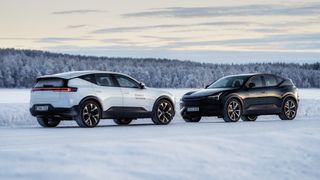
(Image credit: Polestar)
This being Polestar, a slightly sportier version called the ‘Performance pack’ and priced at £85,500 sees its power increased to 380 kW (510 bhp) and torque jumps from an already-potent 840 Nm (619 ft-lbs) to a massive 910 Nm, or 671 ft-lbs. This lowers the 0-60 mph sprint to 4.6 seconds and the range falls to 348 miles, while the 130 mph top speed remains unchanged. Opting for the Performance pack increases wheel size from 21 inches to 22, introduces a sportier ‘Polestar Engineered’ chassis and instals gold seat belts that look a lot better than they sound.
(Image credit: Polestar)
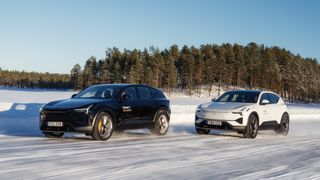
(Image credit: Polestar)
Speaking of the lake, it’s time to learn all about the 3’s stability system and clever torque vectoring.
At first I drive with the system fully switched on. The studded tyres serve up a decent amount of traction, while the car’s stability control gently intervenes to help you continue in your chosen direction, instead of immediately cutting all power the moment a fraction of wheelspin is detected. It’s a neat demonstration of how far these systems have come since the early, somewhat more binary days of electronic traction and stability control.
It isn’t groundbreaking though, so I soon switch the driving mode from Comfort to Performance. The safety systems remain in place, but now I’m on a longer leash and torque vectoring is enabled. Now, when the car detects wheelspin as I accelerate through a corner, more torque is sent to the wheel with most grip, which due to weight transfer tends to be on the outside of the corner. The result is a moderate but neatly controlled slide that demonstrates how the car lets its driver continue to make good progress, while letting them know the safety net isn’t far away.
The system comprises an electric motor attached to the rear axle via a differential with dual clutch packs. These allow the motor’s full torque output to be distributed equally, or for all torque to go to just one of the rear wheels, or anything in-between. The rear motor can also be disengaged entirely, making the Polestar 3 front-wheel-drive when cruising to improve energy efficiency and extend battery life. Although such systems have appeared on some cars before, this is claimed to be the first use of such a differential on an EV.
(Image credit: Polestar)
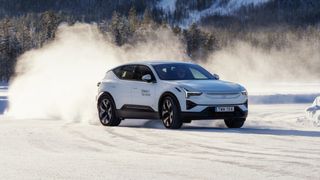
(Image credit: Polestar)
This all adds up to demonstrate what’s possible with the big torque and fine precision of an electric motor. And, while I didn’t head off-road (or indeed off-ice) during my time with the Polestar 3, the technology should prove useful on rough terrain. Here, torque would be pushed to the wheel with the most grip, or taken away if not in contact with the ground.
(Image credit: Polestar)

(Image credit: Polestar)
After a whole day of driving across all three test tracks, I feel I’ve got the hang of the Polestar 3. With all of the safety systems enabled it feels properly surefooted. But with the systems relaxed and torque vectoring switched on, it gives its driver a huge amount of confidence. And even with the stability control disabled the car clearly has the sort of neutral but communicative balance that exudes a sense of having been set up properly. You can thank the Polestar engineers who have spent two winter seasons and many weeks above the Arctic Circle for that.
What else? These are pre-production prototypes, so I can’t dig too deeply into the details. But I can say the low seating position makes the 3 feel smaller and more nimble than you might expect. The interior looks and feels good, although anyone upgrading from aPolestar 2will wonder where some of that car’s physical controls have gone. It’s a decent infotainment system though, built onAndroidAutomotive and with a big, 14.5in touchscreen that is as bright and sharp as it is responsive.
(Image credit: Polestar)
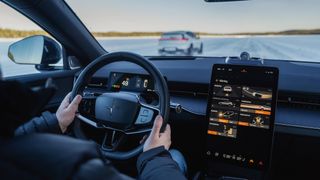
(Image credit: Polestar)
I still wish car makers would bring back physical controls for the climate, steering wheel and side mirror adjustment – all of which are missing from the 3 – and remove touch-sensitive buttons on steering wheels, while they’re at it. But at least Polestar has had the sense to fit a driver display behind the wheel and not relegate the speedometer to the central screen, as seen on the Tesla Model 3/Y andVolvo EX30.
I’m a big fan of the panoramic glass roof, and there’s a good amount of space across both rows of seats. Nice level of refinement too, and the same Scandi-cool styling with which drivers of recent Polestars and Volvos will be familiar.
Today’s best EV Chargers deals$599View$599View$619.99ViewWe check over 250 million products every day for the best prices
Today’s best EV Chargers deals$599View$599View$619.99ViewWe check over 250 million products every day for the best prices
Today’s best EV Chargers deals
$599View$599View$619.99View
$599View
$599View


$599View
$599
$599
$599View
$599View



$599View
$599
$599
$619.99View
$619.99View



$619.99View
$619.99
$619.99
We check over 250 million products every day for the best prices
We check over 250 million products every day for the best prices

Sky Stream gets a great new trick that unlocks long hidden potentialA Sky Stream puck update gives you a host of new channels
A Sky Stream puck update gives you a host of new channels

If you ever needed proof that cassette players are back, this is itWe Are Rewind has made a portable tape deck so retro it should appear from nowhere in a DeLorean
We Are Rewind has made a portable tape deck so retro it should appear from nowhere in a DeLorean